Testing the Speed of BlackBerry Tethering Against My Own Networks
Tags: blackberry, VMwareI’ve been a long-time Cingular customer with my phones, and when they converted to AT&T, everything got wildly complex.
My normal monthly phone bill is hovering between $225.00 and $250.00 each month (yes, really… see below):

This bill consists of my handheld (BlackBerry Bold, $99/month unlimited data + voice + text) + SIM card (inside my laptop, $59/month unlimited data). Since this is effectively two SIM cards, it counts as two separate “phones”.
Oddly though, the one inside the laptop still gets the 9-1-1 surcharge, even though there’s no way I could “dial 9-1-1” from the laptop. If I’m in any sort of emergency situation, the last thing I’m going to do, is fire up the laptop, connect to the LAN, launch Skype and call 9-1-1 from there. But they still charge me $0.35/month for that “privilege”.
I use the laptop while traveling on the train to the office, but when I suspend the laptop and resume it, the Linux “sierra” driver does not wake the SIM card back up. There is no known fix, and I tend to have to close out all of my apps, suspend my VMware sessions, power off and reboot to wake the SIM card back up. Not fun.
I wanted to try to reduce the bill, and spent about 2 hours on the phone today with a lovely woman “Sue” from AT&T to try to discuss my possible options. There are a few, but all have downsides (reduced cost, but reduced minutes or increased minutes, but lose my 20% company discount and so on).
So I’ve been testing tethering my BlackBerry to my Linux laptop, using any number of tools (wvdial, XmBlackBerry, Berry4all).
This does work, if you configure it properly. I ran into lots of trouble with it originally, because /etc/ppp/options had some conflicting options that my hand-written, optimized “blackberry” chatscript didn’t work well with. Once I figured that out, it latched right up immediately.
Writing data size: 4 Modem -> [0x41 0x54 0x48 0xd ] [ATH.] Waiting for PPPD shutdown to complete. Hangup (SIGHUP) Connect time 3.2 minutes. Sent 200888 bytes, received 1852094 bytes. Script /etc/ppp/ip-down started (pid 9381) sent [LCP TermReq id=0x3 "User request"] Script /etc/ppp/ip-down finished (pid 9381), status = 0x0 Network stats thread completed. sent [LCP TermReq id=0x4 "User request"] Connection terminated. Modem hangup PPPD finished
At this point, I could use my BlackBerry as a modem for my laptop and get around the suspend/resume bug with the Linux Sierra driver, but that comes at a price (literally and figuratively).
My laptop’s “phone contract” doesn’t expire until March 2010, and I pay about $53/month for that, and the early termination fee is $175.00. I could cancel that now, and save $90.00, but then I’d have to pay $60.00 for the “unlimited data + tethering” package. I already have a $30 “unlimited data” package on my BlackBerry, and so that would be a net add of $30.00 to the existing $99.00 plan already on there.
But what exactly is the “tethering package” that AT&T offering, doing for me? What am I paying $60/month for? I can tether today. It works. I can continue to consume the data on the data plan side of things, so why pay for tethering?
Basically I’d be saving $23.00 over the cost of a $225+ phone bill, after paying $175 to get out of the existing contract. You can see where this is going.. because AT&T has put some serious mathematicians behind figuring this out, so they can extract every single nickel and dime from your personal monies to pad their coffers.
I wanted to do some speed tests to see what the actual performance gain/loss would be across my local WiFi segment, my laptop’s onboard AT&T card (using the aforementioned “Sierra” driver), and the BlackBerry tethered to the laptop using ppp to “dial out” to the Internet.
Here are the results:
Speed using my home WiFi Connection:
Fast, strong, solid speeds. No complaints, and I use it every day to push gigabytes of data around.

Speed using my BlackBerry tethered to my laptop:
As you can see, the speed is disgustingly slow here. Absolutely useless for anything more than telnet or ssh, and barely even good enough for that.
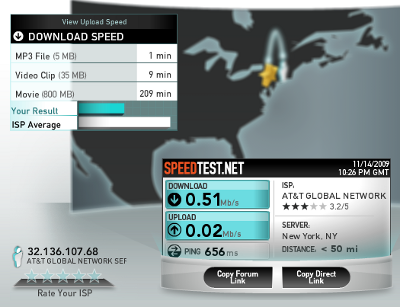
Speed using the onboard AT&T SIM card inside my laptop:
The speed here is reasonable, and acceptable for working on the train.

I just can’t continue to stomach the costs of the whole set of services anymore. $200+/month for a standard phone bill with no overage charges is ridiculous.
From what “Sue” at AT&T told me, everyone who uses a BlackBerry or an iPhone with an unlimited data plan, pays roughly the same amount. I’m skeptical.
I’m going to play with the tethering/ppp options to see if I can’t get some more performance out of it, and roll through to March and discontinue the service that my laptop is currently consuming.
The real question though, is how can AT&T tell if I’m not just using my BlackBerry to stream a ton of data (like through Pandora for BlackBerry), or if I’m tethering?
A Labyrinth of Calendaring
Tags: Palm OS, sync, VMwareWhew!
This week has been absolutely amazing for me, lots of postive successes on all fronts; work and personal. So much energy and glow all around, it’s so very motivating and invigorating.
With all of this activity going on, I’ve been focusing a lot on managing my calendars a bit more efficiently than I probably was before. I have a LOT of calendaring to manage. Here’s a small example of my calendar for this
week (this is a screenshot of my Microsoft Outlook instance below):
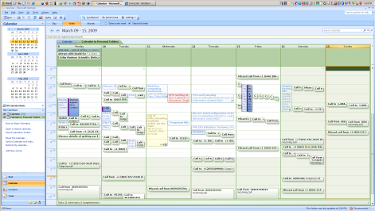
To that end, I’ve (re)discovered the Chandler Project after putting it down a few years ago and also something new called “Funambol” (formerly the sync4j project, based on SyncML).
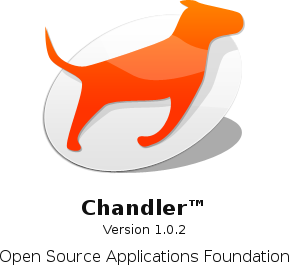
Chandler unfortunately doesn’t build or run on 64-bit Linux systems, so I can’t do any real testing or integration with that at this point. This is 2009, right? 64-bit systems have been around for several years now; at least
long enough to be able to execute a port of Chandler to make it work there. But now it seems that Chandler may be dead now, with Mitch Kapor leaving the project
and taking his funding with him.
Lovely.

Conversely, Funambol installed very easily, runs smoothly, and their administrative GUI is very comprehensive (though, being written in Java, the controls themselves are quite clunky and non-intuitive). There’s a lot of
complicated bits in Funambol, so their documentation portal is a necessary stop if you’re going to install and configure it on your server.
Now the bad news: Neither of them solves the actual problem: universal, location-free calendaring.
What do I mean by that? What I mean is… treating separate calendars as separate in their own realm, but aggregating the relevant pieces where appropriate in the overlap realms.
This means that my personal Microsoft Outlook session running inside VMware, configured with at least 5 separate calendars (Personal, Work, Events, Holidays, Merged) should be treated as separate, and not glommed
together into one sloppy calendar when events are pulled from the individual source calendars. Almost every single sync tool and plugin that claims to support multiple calendars does exactly this. I’ve tried dozens
of them. This is wrong!
Funambol looked promising… except they got it wrong too. For example, the Funambol Outlook plugin only supports one calendar at a time (and sub-folders). You can’t point it to multiple calendars and have it treat them as
separate or even as one merged calendar. Useless.
The Funambol Blackberry app only supports 1 month of prior events and and 6 months of future events when doing an OTA (“Over the Air”) sync to the Funambol server. Also useless.
The Blackberry software, through Blackberry Desktop Manager (based on Intellisync) handles this somewhat cleanly, by allowing me to define as many folders (Calendar folders, Contact folders, etc.) as I want, and then
designating one of those folders as the “default” folder in the sync pairs. Any item I create on the Blackberry goes into that “default” folder, which makes its way to Outlook in the manner expected. If I need it to exist in
another folder, I’ll move it to the other folder when it gets to the Outlook side.
Unfortunately, Blackberry devices are still years behind Palm OS devices with regard to PIM functionality. They’re barely out of diapers. Blackberry devices don’t support Categories for calendar items, for example.
Contacts can have categories, but Calendar items can’t? Huh? HUGE oversight. This is almost as braindead as Apple omitting the very basic Cut and Paste functionality from the iPhone.
Is this really that complicated to solve? Really? In 2009?
So I’ve engineered a process that allows me to keep a clean copy of events on my Blackberry (sans categories, grr!), which is then synchronized over local USB with Outlook running inside a VM (so I can get my work calendar
on my handheld and push my on-handheld events back to Outlook). Outlook is connected to several of my Gmail accounts and Cozi for some additional calendars.
From there, I use a product inside Windows called SyncMyCal to push my calendars upstream to Google Calendar, where they are then marked as either private or shared, depending
on who I need to have access to them.
On the Linux side, Evolution then subscribes to those calendars in Google Calendar, so I can see them from Evolution.
Confused yet? I am too.
My goal is to try to get one central “repository” where all of my PIM data (Calendar, Contacts, Tasks, Memos) can reside. That repository would then have connectors to the other applications and services to manage that PIM
data. Each application would either push, pull or sync their respective bits of data into the repository, where it would then be immediately available/replicated to the other components in the system (based on permissions
and rules, of course).
I thought Chandler and/or Funambol would be this repository. I was wrong, and we’re back to the beginning again.
But at least I have a process where I’m not losing data, I’m keeping everything centralized in one place on my handheld (heavily locked down and very strongly secured; thank you RIM), and I can push it to wherever I
need it from there.
Not only am I trying to augment the lack of core function in the Blackberry to bring it up where my Palm OS Treo 680 was, but I’m trying to merge, maintain and manage 1/2 dozen calendars in at least 3 different systems
(Linux, Windows and Web).
The search continues…
External tools to search Microsoft Outlook 2007
Tags: sync, VMwareI’ve always been Linux and Open Source developer, supporter and user for as many years as I can remember. I’ve always sought to unify my personal space and environment starting with the tools available in the OSS community because they tend to fit my needs a LOT more than most of the proprietary vendor tools. The other benefit of using the OSS solution is
that if I run into a bug, I can either fix it myself or report it and have it fixed upstream very rapidly so everyone can take advantage of the fix.
But there really is no better calendaring solution that I’ve personally found in any flavor or OS than Microsoft Outlook 2007. Sure, it has its faults, as does any product of this level of complexity, but it works well and seems to suit my needs… and also allows me to quickly pull that information around to my other calendars (Work, Personal, Seryn, Holidays, Friends) and I can easily sync my Treo 680 to it to keep my various calendars fresh. I can also sync it to Google Calendar and export it to a CSV or XLS file for import into other incompatible systems.
However, the single biggest flaw that I’ve run into with Microsoft Outlook 2007 is the “Search” functionality. It is downright useless for anything other than taking up toolbar real-estate.
Granted, I’m spoiled by the power and simple flexibility of Google’s search. I’ve never, not even once, needed to go beyond Page 1 of any Google Search Results (SERPs). When I get results, I look at the quality, then tweak my search accordingly and re-submit. I don’t page through multiple pages until I see what I want.
Outlook doesn’t even correctly search all of the words you put into the search box. For example, if you received a message that included a subject of: “::trap id::820 (Server online) ...” and searched for “Server online” (without quotes), you get results that include the word “Server” and results that include the word “online”. If you use quotes (a Google thing), you get 0 results. If you search for “trap id”, you get 0 results. Well that’s just helpful.
I won’t ramble on about the multiple hundreds of other searches that I can clearly see results for in my Inbox, which Outlook quietly ignores… there are plenty. The Outlook search not only sucks, it’s flat-out broken. I don’t see Microsoft spending any time fixing this any time soon.
Enter third-party search tools to the rescue!
I found this thread on a quick Google search for better search tools for Outlook. The results of that thread boiled down to two leading tools:
I decided to give them both a thorough test drive and see which one would suit my needs. I pointed both of these plugins to three email accounts I have configured in Outlook 2007 on my laptop, including one that is very-much littered with attachments of every kind and variety, thousands of calendar items, meetings, and two Gmail accounts… one of them with over 300,000 separate emails in it stretching back 10 years. Believe me, these plugins are going to get a serious workout!
One important thing to note is that my work Outlook instance inside the corporate firewall (also Outlook 2007) is so locked down that I can’t install any add-ons into it. In fact, the whole machine is so locked-down that I can’t even double-click the clock in the corner to see the mini-calendar or add a printer or change the desktop wallpaper or screensaver! At work, I’m stuck with the default, broken-by-design Outlook 2007 search. Since that one uses Exchange, it’s even slower than my local Outlook 2007 instance running inside VMware on my laptop.
Xobni
First, the bugs and negative points:
- Slow, slow slow!
- Requires installing itself as a Windows service which runs all the time, not just when Outlook is running. The problem here is that I keep all of my Outlook data files password-protected (for obvious reasons), and when Outlook isn’t running, the service fires up to index the Outlook data and prompts me for a password. Very inefficient, and doing so loads Outlook, which I do not always want.
- No advanced search (this thing -“not this one” +that)
- Broken search when using punctuation (search for “DBD::Sybase”, for example)
- Seems to incessantly try to get to the net to look up photos, Facebook profiles, LinkIn profiles and so on with no way to disable it. Inside the corporate LAN, none of these sites are accessible, and it drags the search to a crawl, as it attempts to contact those sites and times out.
- Related to the last item, disabling those “Third-party Extensions” (as Xobni calls them), does not remove the buttons for those extensions from the UI, so they are still accessible to be clicked, they still attempt to query the net, and they are still visible on the GUI.
- Nasty bug when backspacing to the beginning of the search box and then typing again. 100% reproducible and annoying. I basically have to type at 1/3 the speed to stop it from triggering the bug. Unacceptable.
- Minimizing the Xobni sidebar uses a minimize widget that sits on the bottom of the bar, completely out of place from the » chevrons for minimizing other widgets which are at the top of each of their respective sidebars.
- Minor nit: The Xobni skin/theme doesn’t match the Outlook skin/theme, so it stands out like a sore thumb and looks like a clunky “bolt-on” rather than an enhancement. If you have the folder tree, Inbox, message preview, Xobni and Task bar all displayed in 4 vertical columns.. the Xobni one (3rd column) really sticks out. In fact, when you minimize the sidebar, it goes from a black/dark skin when exposed, to the proper, Outlook-compatible color theme/skin when minimized. It’s not consistent. Even the size of the chevrons differs in the minimized and maximized versions of that sidebar.
The good points:
- Free as in beer
- Lots of great features that no other search or plugin I’ve found has (“network”, statistics, attachments widget)
- Relatively fast searching and display of results, including a hover preview mode
Lookeen
The bugs and negative points:
- Everything is in a popup window, nothing docks with Outlook itself (like Xobni does, for example). Popups are sometimes ok because they can be minimized and moved out of the way, but in this case, having the search results side-by-side with the actual content would be better.
- Can’t remove searches to re-edit them (changing “Search This” to “Search this” (letter case changes) are ignored when you type them, but are Case Sensitive in the actual search results). Ideally I should be able to expand the search history and hit Delete on each one like I can with the search history in a web browser. I can clear the whole search history, but that’s an all or nothing operation. I can’t delete bogus searches, leaving the others there (which might be frequently-used searches)
- $39.80/USD price tag. While I have no problem paying this for a functional plugin, there are quite a few niggling things that don’t justify that cost at this point.
The good points:
- A LOT faster than Xobni. I mean a LOT. Searching is faster, indexing is faster, everything is faster.
- Between the two, Lookeen handles all sorts of attachments much better and visually represents them in a way that is very quick and easy to visually filter in or out what you’re looking for, IMO. It also has a “Conversations” button in several places that makes zooming into a relevant conversation from a highlighted message or user very quick. Additionally, you can go from 1 day, 1 week, month of conversations to further narrow your search results and scope. Very well thought-out.
- Lookeen docks in the toolbar, which has a few advantages, while Xobni docks in the sidebar (and based on its featureset, leverages slightly different advantages there)
The Conclusion
Ultimately, I’ll probably continue to use Lookeen, because it does what it advertises to do much better… searching and finding. Yes, their implementation of searching is a bit “clunky” with the popup windows instead of docking against Outlook, but I can deal with that for now. The graphical slowness and constant “Internet poking” that Xobni does completely negates any benefits it provides with the statistics and grouping of messages and search results.
I’m still looking for other options that Lookeen and Xobni provide. If anyone has any ideas or suggestions, I’m all ears.
VMware fix for USB Palm connectivity
Tags: sync, VMwareIf you’re like me, you use VMware Workstation heavily. I use it for testing, development, cloning and all manner of other things. One thing that has nagged me since upgrading to the 6.x series of Workstation is that native USB Palm synchronization stopped working.
I can sync over Bluetooth to Windows XP running inside the VM, but I can’t sync natively using the USB cable itself. Windows sees the device as a “Palm Handheld”, VMware connects it, all looks good… but it never actually wakes up the Palm HotSync applet in the System Tray.
Apparently VMware added “port reset forwarding” to the host for Workstation 6.5 but Palm devices (most, if not all) don’t work with this change. To offset that, they’ve added a way to control this, including a new way to control the “skipsetconfig” parameters on a per-device basis.
First, you’ll need to find the vendor id (vid) and product id (pid) of the Palm device you’re trying to connect to. You can usually snarf this out of the vmware.log for that VM session. Mine reported something like this:
Nov 23 13:56:52.371: vmx| USB: Found device [name:Palm\ Handheld vid:0830 pid:0061 path:5/1 speed:full family:vendor]
This means the Treo 680 was: vid:0830 pid:0061
You’ll also note that these are identical to the vendor_id and product_id that we use in pilot-link and other projects on the Linux side.
Then, you add a usb.quirks.deviceX line with the vid:pid pair, followed by the quirk. The two known “quirks” that help USB Palm devices are skip-setconfig and skip-reset. Here is the quirk entry to add to your VM’s vmx config file for the above example:
usb.quirks.device0 = "0x0830:0x0061 skip-setconfig, skip-reset"
Note that you need to use a 0x to denote that the number is hex, which is different from the vid:(hex number) used in log line and autoconnect lines. If you don’t put a 0x, it assumes a decimal number.
From the original thread in the VMware forums:
“This also acts differently than the usb.generic.skipsetconfig setting in that the skip-setconfig is only activated for a specifc device using a quirk versus having it turned on for all devices with the global usb.generic.skipsetconfig. Most devices can tolerate receiving multiple setconfigs and most devices don’t use anything but the first config. There are some devices that may need to set a second or third config, so using a skip-setconfig quirk for only those devices that need it and not using the global usb.generic.skipsetconfig is preferred.”
After setting this, uninstalling Palm Desktop, shutting down VMware entirely, rebooting and reinstalling Palm Desktop + HotSync, everything started working again.
Keeping clean and shiny (Microsoft) Windows
Tags: VMwareI have two Windows machines here that I use for those tasks that don’t quite lend themselves to Linux or Windows-in-VMware. I thought they were updated to current with all latest versions, service packs and updates… until I stumbled on a tool called Personal Security Inspector by Secunia.
PSI is a tool that will scan all of your programs and applications and tell you which ones are vulnerable, insecure, out of date, end-of-lifed, and many other things.
I ran it on my Windows laptop which is only about a month old, straight from IBM… and it scored 88%.
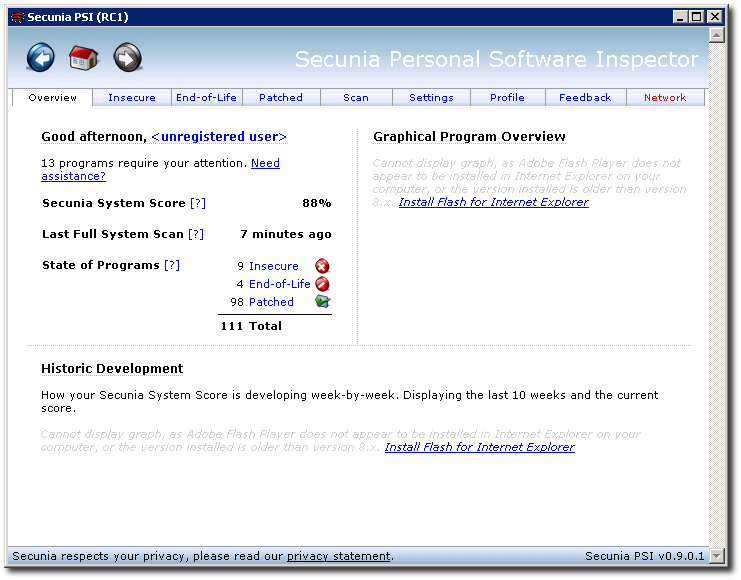
[More screenshots here]
The interface is very smart, and once it finds the applications which need updating/patching, it lets you download them directly from the PSI dashboard, where you can install them and re-run the scan.
As you can see in the above screenshot, 9 programs that were out of date were found on my system and needed updating. These included things like Firefox, the Adobe Flash plug-in, VLC, XnView and others.
After I updated as many as I could, I re-ran the scanner and it now found the following results:
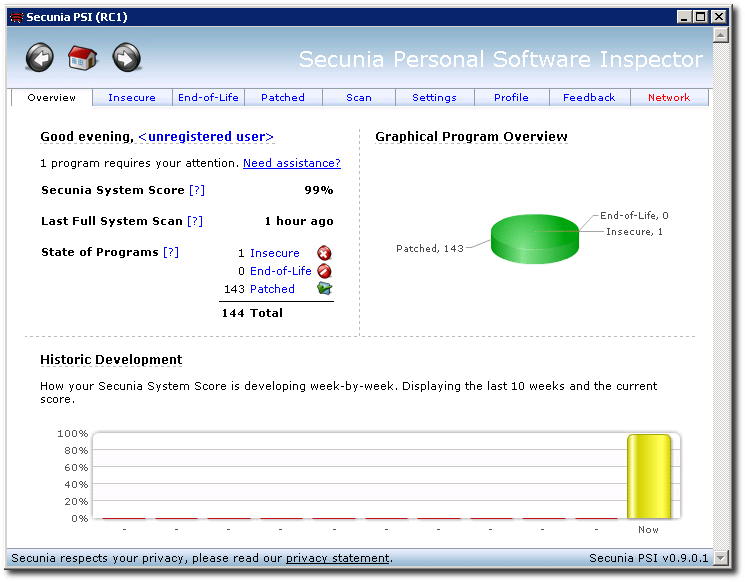
[More screenshots here]
You can see that even the interface changed, because now I have the proper Flash version installed and configured within MSIE to render those graphs on the right-side.
There’s a lot more to it, and I haven’t done it enough justice here, but if you run Windows.. give this a try and see if it doesn’t find many things on your system that could be potential security holes on your machine.
The only one I couldn’t seem to update was the Adobe Acrobat application but I’ll look into that later.
A Busy Weekend to End a Busy Week
Tags: Perl, servers, sync, VMwareThis weekend was just as busy as the week at work. It’s Sunday afternoon, and I’m still going…
Reconstructing Maildir from Backups
-
Moments ago, I found that my archive of the Coldsync mailing list in Maildir format somehow became corrupt, so attempts to copy those messages to Gmail failed using my Thunderbird trick.
I found an older copy that was in mbox format, and used the “Perfect” mbox to Maildir converter script to convert it to Maildir format.
Now I’m back to populating Gmail with my email once again (8,427 in Gmail now, with about 112,000 left to go).
Calendaring Conundrum
-
Also this past week, I realized that my calendar in Outlook had somehow duplicated over 1,700 of my events. I’m sure it was the result of using things like PocketMirror and other sync tools for Palm with it. I’m going to be cleaning that up next. That requires manual, visual inspection of each event, to make sure I’m deleting the dupe and not the original (thus leaving the dupe copy on the calendar). Very odd.
Once that is done, I have to reinstall all of my Palm conduits on the Thinkpad X61s and get that all sync’d to my Treo. With everything on my Treo, I can then begin consolidating my various calendars and task lists into one clean interface.
Back to the Blog; 8 years of postings
-
I also cleaned up 8 years of blog postings, reformatted them all and cleaned up the broken HTML that was the result of importing the diary entries from Advogato. That was 353 separate posts to go through by hand and clean everything up. Now it looks as it should.
Going back and reading through those old diary posts was… interesting. I didn’t realize how much I’d done in those 8 years, all of the people I’d met, projects I’d completed, places I’d been. I might turn the whole blog into a set of memoirs for my daughter Seryn for when she’s old enough to understand all of the things her daddy did in his life.
Movies, movies, movies!
-
I managed to pack in watching 4 movies while I worked this weekend, but the two best ones were “Maxed Out” and “The Man from Earth“. Both of them were equally good, and worth watching. I highly recommend both of them.
“Maxed Out” was eye-opening, and depressing at points, because of the situation our country is in right now. People are literally killing themselves (3 cases are described in the movie) because of their debt. The industry specifically caters to those who can NOT pay their debts down, because those people are the cash-cow for them. These people pay their minimum payments for life and pass on their debts to their children. They don’t want people who pay their credit cards in-full every month to be their customers, there’s no profit in that. Watch the movie for the rest of the details.
“The Man from Earth” brings new ideas to our concepts of religion, biology, archeology and many other fields of traditional study. It reminded me somewhat of the information that was in the first 1/3 of “Zeitgeist: The Movie” (freely downloadable, or viewable online). The Man from Earth is a low-budget movie, but packs a punch in the back story. I won’t spoil it here, but definitely go rent it if you can.
AT&T WWAN in VMware
-
I managed to get my physical Windows machine (an HP machine I purchased at BestBuy a few years ago), virtualized and configured in VMware using VMware Converter. I had to hack into it to get the vm to recognize my legitimate Microsoft Product Key, but after that, it was a snap.


Then I installed and configured the AT&T Communication Manager software to talk to the physical SIM card inside my laptop, so I can go online with the laptop wherever there is valid GSM signal, at 3G speeds.
I didn’t think the vm would recognize the physical card in the machine, if Linux didn’t see it natively… but it does. It’s a bit slow, but at least I can function with one laptop connected to the WWAN on the train with a larger screen at 1920×1200 resolution, instead of the smaller laptop with the 12″ screen at 1024×768 resolution.
The next step is to get the second laptop networking across the connection that the first laptop provides. That should be interesting to solve, since one of these is Windows, and the other one is Linux.
One possible solution would be to take the SIM card that is physically inside the laptop, put it into an external 3G PC-Express card (as in the image here), and then put that into a WWAN router, and carry THAT with me on the train. It has to be portable, of course…
But if I use that approach, not only can I share the connection with both of my laptops, I can also provide “free” wireless to anyone on the train who wants to get online. Maybe I can solicit free beer or donations in the cafe car to help offset those costs.
New Web SEO
- An old acquaintance from a Business Development Group in New London has recently contacted me asking me for help with his website. He pointed out that his site is losing customers to two other sites in his very narrow niche here in Connecticut.
I looked at the competition, and noted that they’re not doing anything special that would merit that increase in customers for them. But I also noted about a dozen problems with this person’s company website in question, that needs immediate attention. His site is ranking at PR0, and the other two sites are pushing PR1/PR2, with no real traffic.
So I think I might pick up a little side project to help him out, to bring his site up to where it should be, and up to the level of standards that I consider acceptable. It looks like it’ll be fun, and it should bring in more income to help fund some projects I’m working on in the background (mostly Seryn’s secret project :)
I make a decent amount of money with my websites now, and I think with the proper care and attention, he can too.
Wrestling MySQL
-
Speaking of websites, a few months back, I started making some MFA 2.0 websites of my own, based on WordPress that are populated with hundreds of public-domain articles on niche content.
To do that, I wrote some tools (in Perl, of course) to spider the remote sites, pull the articles, and stick them into my WordPress databases, complete with proper author in the Author field, original posting date and so on.
Here’s one example that took me less than an hour to create and populate with articles, using these tools.
This particular site has 220 articles in it, but if you look at them articles, they’re all linked to external quality citations and resources. This site, with zero marketing, pulls in an average of about 6,000 hits a month. I have a handful of others, with between 200 and 1,000 articles in each, all of similar high-quality and care behind their creation.
The hard part is that in order to have an article attributed to an author in WordPress, that person has to be in the User table. That gets complicated to get right, but I managed to figure it out.
But I needed a way to ensure that the site’s content didn’t remain “stale”, so I came up with another trick to do that:
UPDATE wp_posts SET post_date='1999-01-01' + interval rand() * 3391 day; UPDATE wp_posts SET post_modified = post_date;
I put this in /etc/cron.weekly/, and now my articles are randomized on a weekly basis, so visitors or search engines coming to the site will constantly see “new” content.
So far, they’re doing well, and bringing in more than enough to cover the monthly costs of running the servers, bandwidth and power.
The Day Job
- The day job continues to go well, and I’m picking up significant speed on those projects.
The more I work within the system, the more I see where some “optimization” can be put into place, including some automation to make things much easier for myself and others in my group. I need to carve out some time to do exactly that, within the limits of my time allotted for the critical tasks that have established deadlines.
The commute has worked itself out and my routine is fairly static now, so that is no longer an unknown. Now I just need to get my foot in the door and keep things moving forward at a cheetah’s pace.
Fun times, definitely fun times. The positive energy has come back in rushing waves, and the good luck has overwhelmed me.
Day of the Dueling Defragmenters
Tags: VMwareI use a lot of VMware images in my day-to-day work (community and otherwise). Snapshotting, adding software, removing software and testing various packages tends to create a VERY fragmented virtual machine.
Since these are basically multi-gigabyte files, thrashing the virtual disk because it gets fragmented, plows performance into the ground, so I tend to try to defragment these volumes as often as I can.
There are 4 basic defragmenting programs; 1 of them built into Windows itself:
- Disk Defragmenter (Start -> Programs -> Accessories -> System Tools -> Disk Defragmenter)
- Diskeeper Lite (may no longer be available, but you can still get it from here).
- Raxco PerfectDisk 2008
- O&O Defrag Free (also available via MajorGeeks link)
Each of these has it’s positive and negative points… the only one I’ve tried that actually will “pack” the files into one contiguous amount of space, is the Raxco PerfectDisk product. This is useful if you tend to grow and shrink your VMware volumes, or want to be sure there is no wasted space in the virtual image while you transfer it over a network or to different machines on a LAN.
Diskeeper Lite is the only one I’ve found that BREAKS the Windows default disk defragmenting tool after you uninstall it. Once you install Diskeeper Lite, it registers itself as the default defrag tool (but doesn’t actually ASK you first, grr!).
When you uninstall it, you don’t get the built-in Windows defrag tool back… you get a broken snap-in. It will fail with the following error in a popup dialog:
Snap-In Failed to Initialize: CLSID:{43668E21-2636-11D1-A1CE-0080C88593A5}
Then you’ll see the Disk Defragment snap-in window with the following displayed:
Snap-In Creation Failed. The Snap-in is not created, it may not be installed properly.
To fix this issue, enter the following commands from Start -> Run or from a cmd.exe command shell to re-register the components that Diskeeper Lite broke:
regsvr32 dfrgsnap.dll regsvr32 dfrgui.dll
Lately, O&O Defrag has been causing X to dump on me, dropping me out of vmware and out of X and anything else I had running at the time. Oops!
I’m back to the default Windows defrag tool for now. It isn’t fast, it doesn’t pack files into a contiguous block, but it comes with the OS and it doesn’t crash my GUI or vmware.
Patch to build TrueCrypt v4.3a modules on 2.6.23+ kernels
Tags: VMwareI run kernels directly from Linus’ git tree on my Thinkpad T42p laptop. As such, things like wireless drivers (madwifi-ng in my case), VMware modules and TrueCrypt require patching of the various bits of code to get it all working.
A lot of people are having trouble building TrueCrypt on 2.6.23, 2.6.24 and later kernels… and nobody has a solution, but there are a lot of people posting on the various Gentoo, Slackware and other forums with the issues.
The errors you’ll see will look like this:
Checking build requirements... Building kernel module... /src/truecrypt-4.3a-source-code/Linux/Kernel/Dm-target.c: In function ‘dereference_bio_ctx’: /src/truecrypt-4.3a-source-code/Linux/Kernel/Dm-target.c:378: error: too many arguments to function ‘bio_endio’ /src/truecrypt-4.3a-source-code/Linux/Kernel/Dm-target.c: In function ‘dm_truecrypt_init’: /src/truecrypt-4.3a-source-code/Linux/Kernel/Dm-target.c:659: error: too many arguments to function ‘kmem_cache_create’ make[2]: *** [/src/truecrypt-4.3a-source-code/Linux/Kernel/Dm-target.o] Error 1 make[1]: *** [_module_/src/truecrypt-4.3a-source-code/Linux/Kernel] Error 2 make: *** [truecrypt] Error 2 Error: Failed to build kernel module
And here’s the patch I just wrote to allow this to build cleanly against 2.6.23 and 2.6.24 kernels:
--- /src/Dm-target.c.orig 2007-04-24 12:32:06.000000000 -0400
+++ Kernel/Dm-target.c 2007-12-29 22:34:21.502087564 -0500
@@ -375,7 +375,7 @@
if (!atomic_dec_and_test (&bc->ref_count))
return;
- bio_endio (bc->orig_bio, bc->orig_bio->bi_size, bc->error);
+ bio_endio (bc->orig_bio, bc->error);
mempool_free (bc, tc->bio_ctx_pool);
}
@@ -656,7 +656,12 @@
goto err;
}
- bio_ctx_cache = kmem_cache_create ("truecrypt-bioctx", sizeof (struct bio_ctx), 0, 0, NULL, NULL);
+ #if LINUX_VERSION_CODE < KERNEL_VERSION(2,6,23)
+ bio_ctx_cache = kmem_cache_create ("truecrypt-bioctx", sizeof (struct bio_ctx), 0, 0, NULL, NULL);
+ #else
+ bio_ctx_cache = kmem_cache_create ("truecrypt-bioctx", sizeof (struct bio_ctx), 0, 0, NULL);
+ #endif
+
if (!bio_ctx_cache)
{
error ("kmem_cache_create failed");
And away you go!
VMware “undefined symbol: g_get_user_special_dir” error SOLVED
Tags: linux, VMwareIf you’re using the latest version of VMWare Workstation, and try to configure it to boot to an ISO image file, VMWare will crash with the following error message:
/usr/lib/vmware/bin/vmware: symbol lookup error: /usr/lib/gtk-2.0/2.10.0/filesystems/libgnome-vfs.so: undefined symbol: g_get_user_special_dir
To solve this problem, simply launch VMWare with the following variable in your environment:
VMWARE_USE_SHIPPED_GTK=no vmware
Now you’ll get proper, working VMWare Workstation, using your native GTK+ on the system.
Solution to prc-tools on AMD64 and other 64-bit machines
Tags: google, linux, servers, VMwareIf you’re like me, moving to the latest 64-bit hardware has made an ENORMOUS difference in my productivity. I’ve moved all of my personal machines and servers to AMD64/4600+ machines with a minimum of 4gb of RAM.
The problem is that not everything moves over so seamlessly; case in point: prc-tools. The problem with prc-tools not functioning on AMD64 has nothing to do with John Marshall, the maintainer of prc-tools… John is a great person, once you get used to how he works and how he expects bug reports and submissions <ducking from johnm’s swing>
I use prc-tools in several-dozen hourly cron jobs to build Palm software for projects like Plucker and several others, and I wanted to decommission the existing AMD32 machine that was doing those builds up to this point to migrate everything to the faster, less power-hungry AMD64 machines.
I didn’t really want to have to move everything to the new AMD64 machines EXCEPT this one AMD32 machine powered up @400W 24×7 just to build Palm software. That would cost me too much money each month in power costs for a server which isn’t really being used for anything other than cranking out hourly builds of Palm software.
prc-tools is a series of patches to the mainline gcc compiler that we’re all used to using on Linux and other POSIX systems like BSD and Solaris. The problem is that the prc-tools patches are mated to gcc-2.95, which was released back in July 31 of 1999. 64-bitness didn’t even exist back in 1999, 8 years ago.
I’m also not the only one with this problem.
I started patching up gcc’s configuration files to detect 64-bit procs a bit better, but it dead-ended quite early. The autoconfiscation process doesn’t even detect the architecture via config.guess. Dropping in a more-recent config.guess and rewrapping configure.ac helped a little bit, but it died further on in the process. Iterative fixes got it quite far, but eventually I had to dive into gcc itself to patch it, and that’s an area I leave to more-seasoned experts than myself.
Read the rest of this entry »
